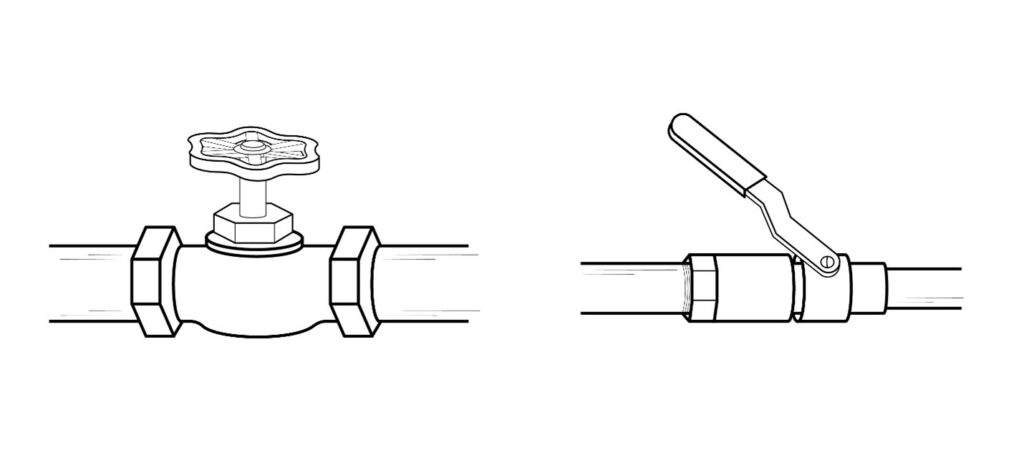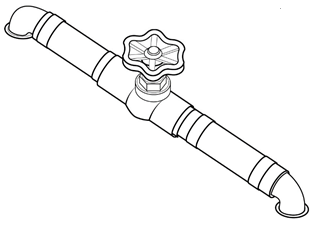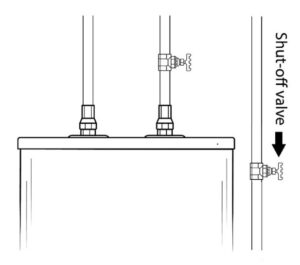The ideal time to locate the emergency water shutoff is not during an actual emergency. Unfortunately, until they must, most people never think about locating the emergency water shutoff. Quickly finding the shutoff in a home, especially in a multifamily homeowner association (HOA), can be the difference between hundreds of dollars or thousands of dollars in damage.
One positive point with many HOAs is that the same homebuilder constructed all the homes in the HOA. In these instances, the homebuilder many times retained the same architect to design the homes and used the same plumbing contractor to install the plumbing throughout the HOA. If this happens to be the case, the emergency water shutoff may be located in the same place throughout the homeowner association. Unfortunately, even if the HOA had the same builder and plumbing contractor, there is no guarantee that the emergency water shutoff valve will be located in the same place in every home. The uncertainty of the shutoff location could even be the case when homes within the HOA have the exact same floorplan.
The expense of individual homeowner insurance, and with multifamily HOAs’ master insurance policies being what there are, insurance claims need to be reduced whenever possible. So, knowing where and how to use the emergency water shutoff can help mediate water damage claims. If a homeowner does not know where to locate their emergency water shutoff or even what to look for, this blog should provide some basic guidelines to assist. In certain instances, contacting a professional plumber to seek out this shutoff may be necessary.
The emergency water shutoff is a valve, and this valve could possibly be in the basement, crawlspace, garage, utility room, beneath the kitchen sink, pantry, or front coat closet. With this being said, the emergency water shutoff could be in none of these locations. So, finding the shutoff valve might be a bit of a seek and find process.
In addition, there is typically a main water shutoff with the meter at the street, or in the front yard a few feet from the street. This is typically where the water meter service for the home is located. These shutoffs can be found in the street covered by a small steel plate, many times marked “Water” or “Water Meter.” In newer construction, the water meter box may be located in the front yard in a fiberglass box, typically green or gray in color. Over time these boxes can become covered with landscaping materials and make them more difficult to find. These street shutoffs may also require a special plumber’s key or “T” to shut the water off.
While the location of the water shutoff may not be easily discernable, what to look for may be more easily defined. Shutoff valves are typically of two designs, gate valves and ball valves. Gate valves are identifiable by their round turning handle (see illustration left below). These valves are closed by turning the handle clockwise. Think of the old saying: righty – tighty (turn to the right), and lefty – loosy (turn to the left). Ball valves have a lever-type handle that is open when aligned with the pipe and closed when turned at a right angle of 90 degrees from the pipe (see illustration right below).
The floor-mounted water shutoff (see illustration below) seems to be the most elusive to find. Typically, these shutoffs are located on the floor in coat closets near the front door or possibly in kitchen pantry closets. The reason these shutoffs seem to be so elusive is that they are located in the back of these closets.

Being typically located in the back of a closet, these shutoffs tend to be forgotten about or not even noticed. If being located in the back of the closet is not enough, many times the closet becomes so filled with items, the shutoff valve is inadvertently hidden. Ironically, one of the reasons for placing the shutoff in these locations is the notion that it will be seen when the closet door is open. Sometimes these closet valves will be located on a wall instead of the floor in a closet or the kitchen pantry.
These closet shutoff valves are typically located on the main waterline protruding up through the closet floor for 18 to 24 inches and then, turning back through the floor. A shutoff valve is placed on this exposed waterline.
In the event the emergency shutoff valve cannot be located in the living area of the home, the next area to check is the garage, then the crawlspace or basement. In the garage, the valve will typically be found on the exterior wall closest to the street. In the crawlspace or basement, in most cases, the waterline is exposed and visible. The main water line being visible is a benefit in that this allows for the line to be inspected for a shutoff valve.

The water heater typically will have a water shutoff valve in the vicinity. In an emergency the water heater, if the shutoff valve location is unknown, is the first place to check. The immediate area around the water heater is many times the location of the main water shutoff. Or, at the least, the water heater may have an auxiliary shutoff that can accomplish the same result as the mainline shutoff valve. The line that supplies the water heater typically comes directly from the main waterline. Plumbers will place a shutoff right before the line feeds into the water heater (See illustration for specifics).
Along with the HOA membership being encouraged to familiarize themselves with where their home’s emergency water shutoff is located. HOA members who rent their homes should inform their tenants where the home’s emergency water shutoff is located. It is a common practice of proactive landlords to label and paint water shutoffs red for easier identification. Another common practice is for landlords to place labels on cabinets denoting the emergency water shutoff is located within.
WDMC
William Douglas Management offers management services:
HOA Property Management Charlotte NC
HOA Property Management Raleigh NC
HOA Property Management Greenville SC
HOA Property Management Greensboro NC
HOA Property Management Charleston SC
HOA Property Management Columbia SC
HOA Property Management Myrtle Beach SC
HOA Property Management Mooresville NC
HOA Property Management Fort Mill SC
HOA Property Management Asheville NC
© Copyright 2021 – William Douglas Property Management, Inc.


